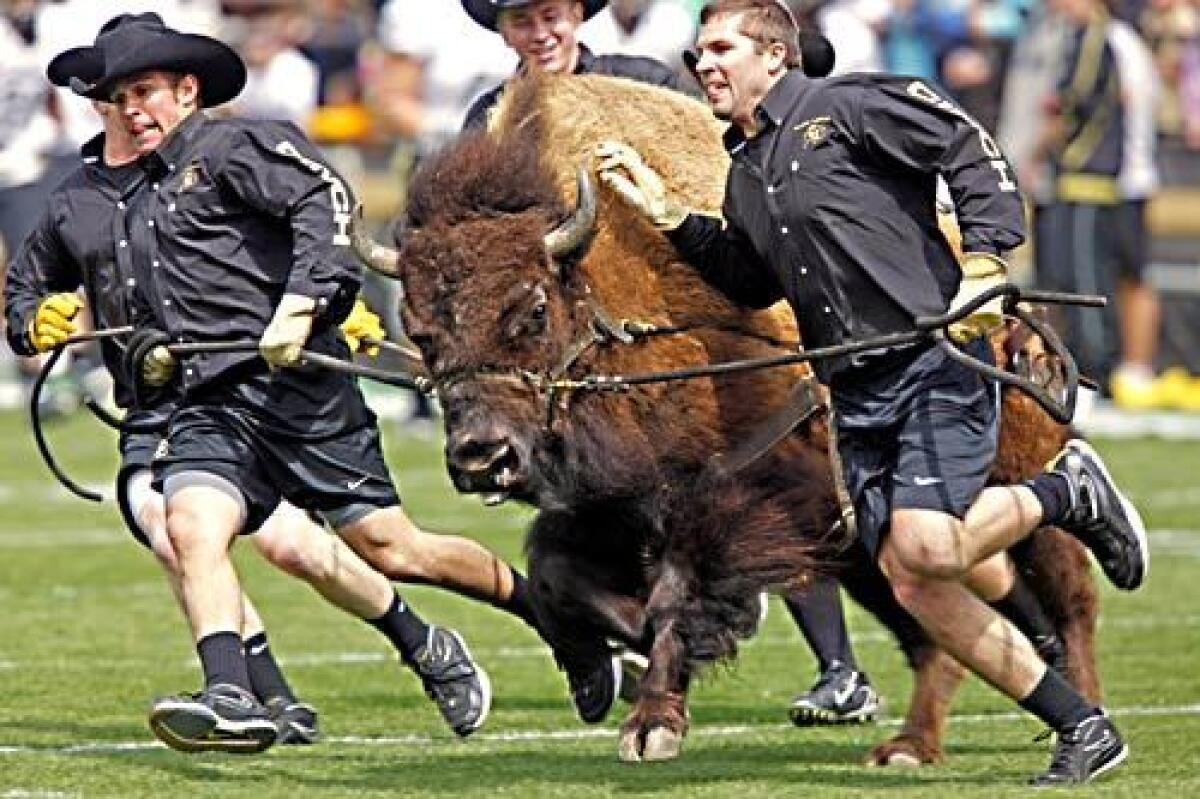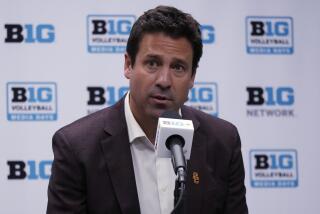Two new Pac-10 teams: Their home turfs are also a travel opportunity

The familiar symmetry of the Pacific 10 Conference is changing, and that calls for a road trip.
By joining the Pac-10 in 2011, the universities of Utah and Colorado will make it the Pac-12. With that, the rhythms of USC and UCLA fans traveling to the Arizona schools, the Bay Area schools, the Oregons and the Washingtons will be transformed. (OK, so not so many fans go to Pullman, Wash., which Washington State calls home.)
Call Colorado and Utah the new Mountain time schools. But they bring more to the league than athletic histories stocked with NCAA ski titles.
Boulder, Colo.
Colorado won a national championship in football in 1990. But NCAA violations and off-field woes have set the program back, and the Buffaloes haven’t played in a bowl game since 2007.
Yet Boulder, with 100,000 people and 300 miles of bike lanes, is the new gem of the Pac-12 — a sophisticated, environmentally conscious, walkable town with far more in common with Palo Alto or Eugene, Ore., than it had with some of the Midwestern burgs of the Big 12 Conference, which Colorado was leaving.
It’s also an ideal place to leave the car at the hotel and walk to Folsom Field, Colorado’s 53,613-seat stadium. The Millennium Harvest House hotel is a five-minute walk along the Boulder Creek Path, the biking, walking and jogging trail that winds through the city. I was tempted by the soothingly sleek, stylish and expensive St. Julien Hotel & Spa, a bit farther from the stadium but still adjacent to the path.
USC plays in Boulder next year on Nov. 5, and Trojans fans will find much to do. The city is tucked against the Rocky Mountain foothills 40 minutes northwest of Denver International Airport, making it an appealing destination even without a football game.
A block from the St. Julien is the Pearl Street Mall, a shopping and dining district reminiscent of Third Street Promenade in Santa Monica, but not as hectic.
Besides Pearl Street, there’s Twenty Ninth Street, a planned development of shops and restaurants, and University Hill, the classic collegiate hodgepodge of bars, sandwich shops and burger joints.
The Hill is also home to Cafe Aion, one of Boulder’s seemingly endless array of restaurants that focus on seasonal and locally available ingredients — and at least equally important, delicious and sometimes surprisingly well-priced food.
Because of that, Bon Appétit magazine recently named Boulder “America’s Foodiest Town,” a designation reserved for a city with a population of less than 250,000.
The acclaimed Frasca Food & Wine was closed for remodeling when I visited. But local squash was in season, and I tasted my way through squash with lentils and greens at Laudisio, a gorgeous squash soup at Cafe Aion, and a delicious green salad with golden squash at Salt, a stylishly updated exposed-brick restaurant and bar. I passed on the squash tamales at Zolo Southwestern Grill in favor of the green chile pork tacos, but I got my vegetables.
This, then, is Boulder: At the ultra-popular Pearl Street restaurant and upstairs bar the Kitchen, owners-chefs Kimbal Musk and Hugo Matheson report the purveyors of their ingredients on blackboards, and the restaurant uses wind power for electricity.
About that wind: I encountered great gusts of it at Eldorado Canyon State Park, a stunning hiking and rock-climbing destination about eight miles from town.
As if Boulder needed another distinction or slogan, here’s one more: “Boulder: It’ll blow you away.”
Salt Lake City
Californians might not go to Salt Lake City for the lake or the city. But the Utah football program has gone from giant-killer to a 13-0 team that finished No. 2 in the Associated Press poll in 2008, and the Utes have spent time in the top 10 this season. What’s more, the mountains are tantalizingly close, with Park City 30 miles away and a dozen or so ski resorts within an hour’s drive, though the ski season doesn’t usually open until around Thanksgiving. (UCLA will play here on Nov. 12 next year; if you’re intent on sking in Colorado or Utah, consider a basketball trip.)
The 2002 Winter Olympics left their mark on Salt Lake City, including the Utes’ 45,017-seat Rice-Eccles Stadium, which hosted the Games’ opening and closing ceremonies. The striking cauldron tower that held the Olympic flame — no longer lighted — stands in a plaza outside the stadium.
The setting is beautiful, with a mountain backdrop. But the weather is notoriously changeable in fall. It was 45 degrees and raining at kickoff for the mid-October game I attended. Before the game was over, a rainbow arched over the stadium, new snow visible on a nearby peak.
Another artifact of the Olympics is the massive Grand America Hotel downtown, an over-the-top luxury hotel built before the Olympics and now favored by some NBA teams in town to play the Utah Jazz.
I stayed at the Hotel Monaco, a determinedly hip downtown hotel in a historic building. Though I liked it — and loved my $87 AAA rate — it reflects the tug of war at the soul of Salt Lake City.
The hotel promotes itself as a “progressive urban oasis” that appeals to “the secret desire that we all share to break out of our shells and be a little indulgent … and naughty.”
One of the seeming reasons for the identity crisis is only a block away at Temple Square, the headquarters of the Church of Jesus Christ of Latter-day Saints, commonly known as the Mormon Church.
For Mormons, a visit to the square is a pilgrimage that can include a visit inside the temple itself, off-limits to nonmembers. But any visitor can hear the famous Mormon Tabernacle Choir, now in its 82nd year, rehearse in the domed tabernacle at 8 on Thursday evenings, or watch the taping of its weekly radio and television performance on Sundays, when visitors must be seated by 9:15 a.m.
As for the at-first baffling numbering system of the city’s streets — just remember, Temple Square is the center of it all. Football fans probably will be more concerned about the occasionally baffling alcohol regulations.
Getting a drink is no longer tricky in Salt Lake City, where you once had to pay a small fee to join a “private club” to go to a bar. Some restaurants still are licensed in such a way that patrons are required to order food to order alcohol.
Still, in recent years, brew pubs have proliferated, and stopping in at such downtown spots as Red Rock Brewing Co., Squatters Pub or the classic restaurant and bar the Bayou — also known for live music — there’s little to indicate you’re not in any other state.
One remaining quirk for Southern Californians is the absence of liquor and wine in grocery or convenience stores. It must be purchased at state liquor stores or package agencies, which are closed on Sundays.
Much of the appeal of Salt Lake City lies beyond the grid of its streets, in the canyons and mountains that surround it. In town, City Creek Canyon is a runner’s delight, and Mill Creek Canyon on the outskirts is a lovely spot for a hike or drive. And the best meal I had was the Cajun trout with sweet tomato salsa and a side of grapefruit at Ruth’s Diner, a stylishly remodeled 1930s spot on gorgeous Emigration Canyon Road, lined with trees whose leaves had turned gold and russet.
Lakers Coach Phil Jackson once recommended Ruth’s, so it’s no secret: Be prepared to wait.
However, you can get a drink with your meal, even on Sunday.
More to Read
Sign up for The Wild
We’ll help you find the best places to hike, bike and run, as well as the perfect silent spots for meditation and yoga.
You may occasionally receive promotional content from the Los Angeles Times.






